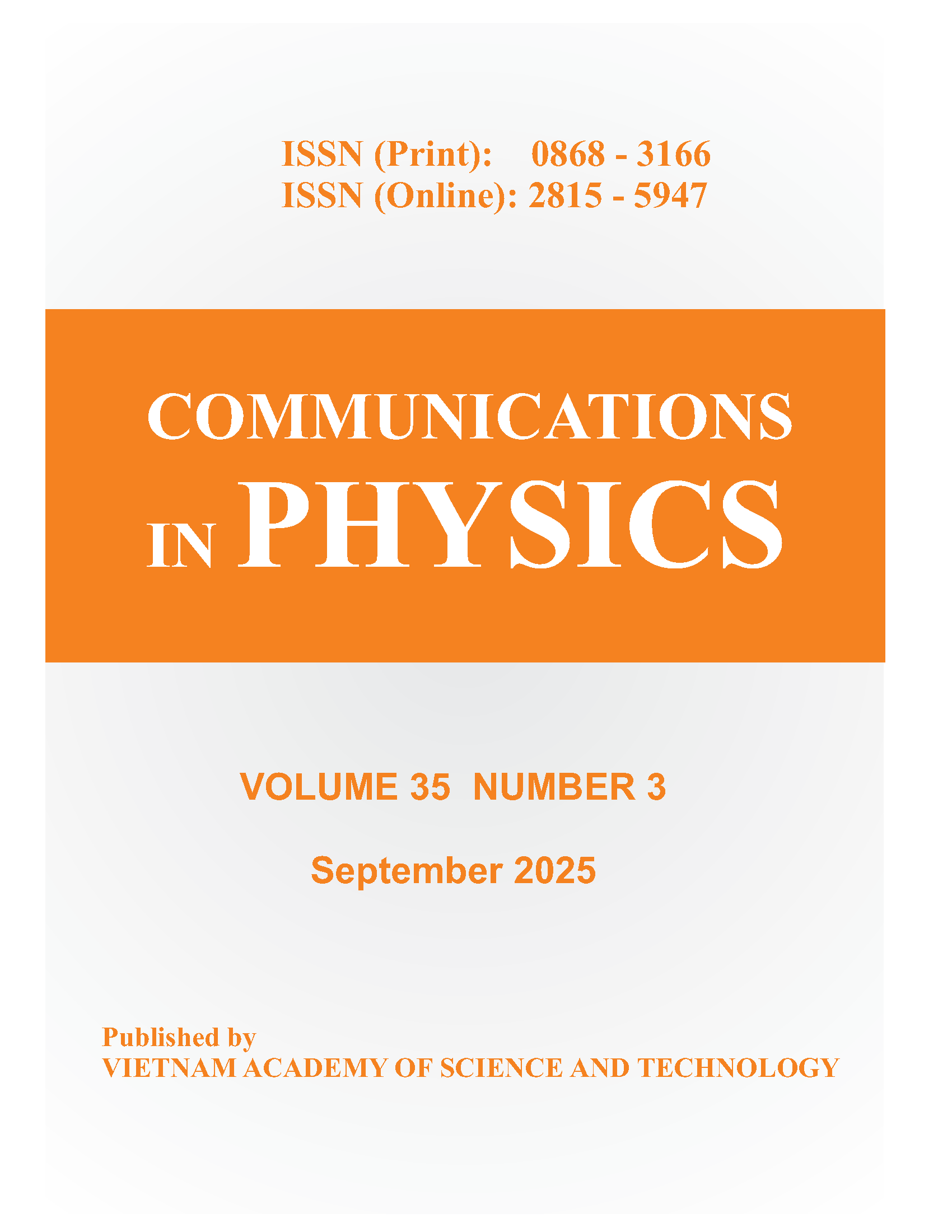Investigation of the radiative decay \(b \to s \gamma\) in the 3-4-1-1 model
Author affiliations
DOI:
https://doi.org/10.15625/0868-3166/17517Keywords:
dark matter, beyond the standard model, standard model, radiative decayAbstract
We investigate the branching ratio of the radiative decay \(b\to s \gamma\) in the 3-4-1-1 model with arbitrary charge parameters \(p,q\). We show that the new Higgs bosons, \(\mathcal{H}_1^\pm\), and the new gauge bosons \(W_{13,14 }^{\pm p,q}, Z_{2,3}\) contribute to this decay. Of these sources, the main contribution comes from the interaction of the singly-charged Higgs boson. If the spontaneous breaking of the enlarged gauge group symmetry down to the electroweak group is around a few TeVs, the predictions for the branching ratio Br\((b\to s \gamma)\) and meson mixing are both consistent with experimental constraints.
Downloads
References
T. Kajita, Rev. Mod. Phys. 88 no. 3, (2016) 030501.
A. B. McDonald, Rev. Mod. Phys. 88 no. 3, (2016) 030502.
Particle Data Group Collaboration, R. L. Workman and Others, PTEP 2022 (2022) 083C01.
G. Jungman, M. Kamionkowski, and K. Griest, Phys. Rept. 267 (1996) 195–373, arXiv:hep-ph/9506380.
G. Bertone, D. Hooper, and J. Silk, Phys. Rept. 405 (2005) 279–390, arXiv:hep-ph/0404175.
J. R. Ellis, J. S. Hagelin, D. V. Nanopoulos, K. A. Olive, and M. Srednicki, Nucl. Phys. B 238 (1984) 453–476.
E. W. Kolb and R. Slansky, Phys. Lett. B 135 (1984) 378.
T. Appelquist, H.-C. Cheng, and B. A. Dobrescu, Phys. Rev. D 64 (2001) 035002, arXiv:hep-ph/0012100.
K. Agashe and G. Servant, Phys. Rev. Lett. 93 (2004) 231805, arXiv:hep-ph/0403143.
N. Arkani-Hamed, A. G. Cohen, E. Katz, and A. E. Nelson, JHEP 07 (2002) 034, arXiv:hep-ph/0206021.
I. Low, JHEP 10 (2004) 067, arXiv:hep-ph/0409025.
P. V. Dong, H. T. Hung, and T. D. Tham, Phys. Rev. D 87 no. 11, (2013) 115003, arXiv:1305.0369 [hep-ph].
D. T. Huong and P. V. Dong, Eur. Phys. J. C 77 no. 4, (2017) 204, arXiv:1605.01216 [hep-ph].
D. Abercrombie et al., Phys. Dark Univ. 27 (2020) 100371, arXiv:1507.00966 [hep-ex].
C. Boehm, P. Fayet, and J. Silk, Phys. Rev. D 69 (2004) 101302, arXiv:hep-ph/0311143.
D. Chialva, P. S. B. Dev, and A. Mazumdar, Phys. Rev. D 87 no. 6, (2013) 063522, arXiv:1211.0250 [hep-ph].
M. Aoki, J. Kubo, and H. Takano, Phys. Rev. D 87 no. 11, (2013) 116001, arXiv:1302.3936 [hep-ph].
S. Bhattacharya, A. Drozd, B. Grzadkowski, and J. Wudka, JHEP 10 (2013) 158, arXiv:1309.2986 [hep-ph].
G. Arcadi, C. Gross, O. Lebedev, Y. Mambrini, S. Pokorski, and T. Toma, JHEP 12 (2016) 081, arXiv:1611.00365 [hep-ph].
D. Van Loi, P. Van Dong, and L. X. Thuy, JHEP 09 (2019) 054, arXiv:1906.10577 [hep-ph].
C. H. Nam, D. Van Loi, L. X. Thuy, and P. Van Dong, JHEP 12 (2020) 029, arXiv:2006.00845 [hep-ph].
A. Ahmed, M. Duch, B. Grzadkowski, and M. Iglicki, Eur. Phys. J. C 78 no. 11, (2018) 905, arXiv:1710.01853 [hep-ph].
S. Bhattacharya, P. Ghosh, A. K. Saha, and A. Sil, JHEP 03 (2020) 090,
arXiv:1905.12583 [hep-ph].
J. Fan, A. Katz, L. Randall, and M. Reece, Phys. Dark Univ. 2 (2013) 139–156, arXiv:1303.1521 [astro-ph.CO].
J. Fan, A. Katz, L. Randall, and M. Reece, Phys. Rev. Lett. 110 no. 21,
(2013) 211302, arXiv:1303.3271 [hep-ph].
K. Agashe, Y. Cui, L. Necib, and J. Thaler, JCAP 10 (2014) 062, arXiv:1405.7370 [hep-ph].
K. Kong, G. Mohlabeng, and J.-C. Park, Phys. Lett. B 743 (2015) 256–266, arXiv:1411.6632 [hep-ph].
H. Alhazmi, K. Kong, G. Mohlabeng, and J.-C. Park, JHEP 04 (2017) 158, arXiv:1611.09866 [hep-ph].
O. D. Elbert, J. S. Bullock, S. Garrison-Kimmel, M. Rocha, J. On ̃orbe, and A. H. G. Peter,
Mon. Not. Roy. Astron. Soc. 453 no. 1, (2015) 29–37, arXiv:1412.1477 [astro-ph.GA].
S. Tulin and H.-B. Yu, Phys. Rept. 730 (2018) 1–57, arXiv:1705.02358 [hep-ph].
D. T. Huong, L. X. Thuy, N. T. Nhuan, and H. T. Phuong, Commun. in Phys. 31 no. 4, (2021) 399–410.
HFLAV Collaboration, Y. S. Amhis et al., Eur. Phys. J. C 81 no. 3, (2021) 226, arXiv:1909.12524 [hep-ex].
M. Misiak, A. Rehman, and M. Steinhauser, JHEP 06 (2020) 175, arXiv:2002.01548 [hep-ph].
T. Inami and C. S. Lim, Prog. Theor. Phys. 65 (1981) 297. [Erratum: Prog.Theor.Phys. 65, 1772 (1981)].
A. J. Buras, F. De Fazio, J. Girrbach, and M. V. Carlucci, JHEP 02 (2013) 023,
arXiv:1211.1237 [hep-ph].
M. Misiak and M. Steinhauser, Nucl. Phys. B 764 (2007) 62–82, arXiv:hep-ph/0609241.
M. Czakon, U. Haisch, and M. Misiak, JHEP 03 (2007) 008, arXiv:hep-ph/0612329.
A. J. Buras, L. Merlo, and E. Stamou, JHEP 08 (2011) 124, arXiv:1105.5146 [hep-ph].
A. Alberti, P. Gambino, K. J. Healey, and S. Nandi, Phys. Rev. Lett. 114 no. 6, (2015) 061802, arXiv:1411.6560 [hep-ph].
M. Czakon, P. Fiedler, T. Huber, M. Misiak, T. Schutzmeier, and M. Steinhauser, JHEP 04 (2015) 168, arXiv:1503.01791 [hep-ph].
Flavour Lattice Averaging Group Collaboration, S. Aoki et al., Eur. Phys. J. C 80 no. 2, (2020) 113, arXiv:1902.08191 [hep-lat].
Downloads
Published
How to Cite
Issue
Section
License
Communications in Physics is licensed under a Creative Commons Attribution-ShareAlike 4.0 International License.
Copyright on any research article published in Communications in Physics is retained by the respective author(s), without restrictions. Authors grant VAST Journals System (VJS) a license to publish the article and identify itself as the original publisher. Upon author(s) by giving permission to Communications in Physics either via Communications in Physics portal or other channel to publish their research work in Communications in Physics agrees to all the terms and conditions of https://creativecommons.org/licenses/by-sa/4.0/ License and terms & condition set by VJS.











